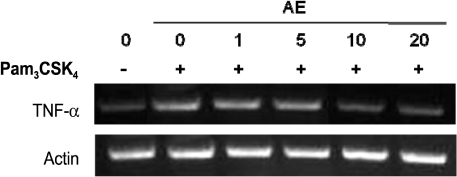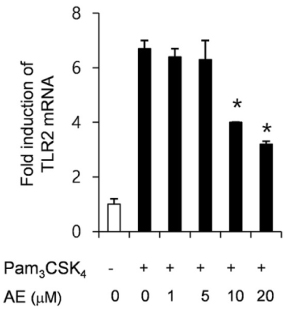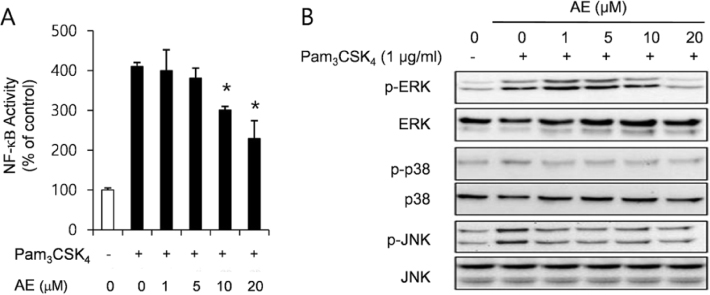J Nutr Health.
2016 Aug;49(4):241-246. 10.4163/jnh.2016.49.4.241.
Aloe-emodin inhibits Pam₃CSK₄-induced MAPK and NF-κB signaling through TLR2 in macrophages
- Affiliations
-
- 1Department of Food Science and Nutrition, College of Natural Science, Soonchunhyang University, Asan 31538, Korea. soon56@sch.ac.kr
- 2Department of Food & Nutrition Education, Graduate School of Education, Soonchunhyang University, Asan 31538, Korea.
- KMID: 2351352
- DOI: http://doi.org/10.4163/jnh.2016.49.4.241
Abstract
- PURPOSE
Aloe-emodin (AE), an ingredient of aloe, is known to exhibit anti-inflammatory activities. However, little is known about the underlying molecular mechanisms of its inflammatory modulatory activity in vitro. In the present study, we investigated the anti-inflammatory potential of AE using Pam₃CSK₄-stimulated macrophages.
METHODS
RAW 264.7 macrophages were treated with AE (0~20 mM) for 1 h, followed by treatment with Pam₃CSK₄ for 1 h. After incubation, mRNA expression levels of cytokines were measured. The effect of AE on TLR2-related molecules was also investigated in Pam₃CSK₄-stimulated RAW 264.7 macrophages.
RESULTS
AE attenuated Pam₃CSKâ‚„-stimulated expression of proinflammatory cytokines, including tumor necrosis factor-α (TNF-α), interleukin-6 (IL-6), and interleukin-1β (IL-1β) in RAW 264.7 macrophages. Two concentrations of AE (10 µM and 20 µM) effectively reduced mRNA expression of TLR2 by 41.18% and 54.43%, respectively, compared to that in control cells (p < 0.05). AE also decreased nuclear factor-kappa B (NF-κB) activation and mitogen-activated protein kinase (MAPK) phosphorylation. Phosphorylation levels of ERK1/2, p38, and JNK were markedly reduced by 20 µM AE. In particular, AE decreased phosphorylation of ERK in a dose-dependent manner in Pam₃CSKâ‚„-stimulated RAW 264.7 macrophages.
CONCLUSION
Our data indicate that AE exerts its anti-inflammatory effect by suppressing TLR2-mediated activation of NF-κB and MAPK signaling pathways in macrophages.
Keyword
MeSH Terms
Figure
Reference
-
1. Farzadinia P, Jofreh N, Khatamsaz S, Movahed A, Akbarzadeh S, Mohammadi M, Bargahi A. Anti-inflammatory and wound healing activities of aloe vera, honey and milk ointment on second-degree burns in rats. Int J Low Extrem Wounds. 2016; 15(3):241–247.
Article2. Al-Oqail MM, El-Shaibany A, Al-Jassas E, Al-Sheddi ES, Al-Massarani SM, Farshori NN. In vitro anti-proliferative activities of Aloe perryi flowers extract on human liver, colon, breast, lung, prostate and epithelial cancer cell lines. Pak J Pharm Sci. 2016; 29:2 Suppl. 723–729.3. Park MY, Kwon HJ, Sung MK. Dietary aloin, aloesin, or aloe-gel exerts anti-inflammatory activity in a rat colitis model. Life Sci. 2011; 88(11-12):486–492.
Article4. Andersen DO, Weber ND, Wood SG, Hughes BG, Murray BK, North JA. In vitro virucidal activity of selected anthraquinones and anthraquinone derivatives. Antiviral Res. 1991; 16(2):185–196.
Article5. Arosio B, Gagliano N, Fusaro LM, Parmeggiani L, Tagliabue J, Galetti P, De Castri D, Moscheni C, Annoni G. Aloe-Emodin quinone pretreatment reduces acute liver injury induced by carbon tetrachloride. Pharmacol Toxicol. 2000; 87(5):229–233.
Article6. Esmat AY, Tomasetto C, Rio MC. Cytotoxicity of a natural anthraquinone (Aloin) against human breast cancer cell lines with and without ErbB-2: topoisomerase IIalpha coamplification. Cancer Biol Ther. 2006; 5(1):97–103.
Article7. Groom QJ, Reynolds T. Barbaloin in aloe species. Planta Med. 1987; 53(4):345–348.8. van Wyk BE, van Rheede van Oudtshoorn MC, Smith GF. Geographical variation in the major compounds of Aloe ferox leaf exudate. Planta Med. 1995; 61(3):250–253.9. Yin JT, Wan B, Liu DD, Wan SX, Fu HY, Wan Y, Zhang H, Chen Y. Emodin alleviates lung injury in rats with sepsis. J Surg Res. 2016; 202(2):308–314.
Article10. Iwanowycz S, Wang J, Altomare D, Hui Y, Fan D. Emodin bidirectionally modulates macrophage polarization and epigenetically regulates macrophage memory. J Biol Chem. 2016; 291(22):11491–11503.
Article11. Nathan C, Ding A. Nonresolving inflammation. Cell. 2010; 140(6):871–882.
Article12. Mosser DM, Edwards JP. Exploring the full spectrum of macrophage activation. Nat Rev Immunol. 2008; 8(12):958–969.
Article13. Kaisho T, Akira S. Critical roles of Toll-like receptors in host defense. Crit Rev Immunol. 2000; 20(5):393–405.
Article14. Barton GM, Medzhitov R. Toll-like receptor signaling pathways. Science. 2003; 300(5625):1524–1525.
Article15. Livak KJ, Schmittgen TD. Analysis of relative gene expression data using real-time quantitative PCR and the 2(-Delta Delta C(T)) Method. Methods. 2001; 25(4):402–408.16. Salvador B, Arranz A, Francisco S, Córdoba L, Punzón C, Llamas MÁ, Fresno M. Modulation of endothelial function by Toll like receptors. Pharmacol Res. 2016; 108(9):46–56.
Article17. McCurdy JD, Olynych TJ, Maher LH, Marshall JS. Cutting edge: distinct Toll-like receptor 2 activators selectively induce different classes of mediator production from human mast cells. J Immunol. 2003; 170(4):1625–1629.
Article18. Redecke V, Häcker H, Datta SK, Fermin A, Pitha PM, Broide DH, Raz E. Cutting edge: activation of Toll-like receptor 2 induces a Th2 immune response and promotes experimental asthma. J Immunol. 2004; 172(5):2739–2743.
Article19. Takeda K, Akira S. Toll-like receptors in innate immunity. Int Immunol. 2005; 17(1):1–14.20. Takeda K, Akira S. TLR signaling pathways. Semin Immunol. 2004; 16(1):3–9.
Article21. Nemmar A, Al-Salam S, Yuvaraju P, Beegam S, Ali BH. Emodin mitigates diesel exhaust particles-induced increase in airway resistance, inflammation and oxidative stress in mice. Respir Physiol Neurobiol. 2015; 215(5):51–57.
Article22. Han JW, Shim DW, Shin WY, Heo KH, Kwak SB, Sim EJ, Jeong JH, Kang TB, Lee KH. Anti-inflammatory effect of emodin via attenuation of NLRP3 inflammasome activation. Int J Mol Sci. 2015; 16(4):8102–8109.23. Gambhir V, Yildiz C, Mulder R, Siddiqui S, Guzzo C, Szewczuk M, Gee K, Basta S. The TLR2 agonists lipoteichoic acid and Pam3CSK4 induce greater pro-inflammatory responses than inactivated Mycobacterium butyricum. Cell Immunol. 2012; 280(1):101–107.
Article24. Li Y, Xiong W, Yang J, Zhong J, Zhang L, Zheng J, Liu H, Zhang Q, Ouyang X, Lei L, Yu X. Attenuation of inflammation by emodin in lipopolysaccharide-induced acute kidney injury via inhibition of toll-like receptor 2 signal pathway. Iran J Kidney Dis. 2015; 9(3):202–208.25. Dahiya Y, Pandey RK, Sodhi A. Nod2 downregulates TLR2/1 mediated IL1β gene expression in mouse peritoneal macrophages. PLoS One. 2011; 6(11):e27828.
Article26. Xue J, Chen F, Wang J, Wu S, Zheng M, Zhu H, Liu Y, He J, Chen Z. Emodin protects against concanavalin A-induced hepatitis in mice through inhibiting activation of the p38 MAPK-NF-κB signaling pathway. Cell Physiol Biochem. 2015; 35(4):1557–1570.
Article27. Yao WY, Zhou YF, Qian AH, Zhang YP, Qiao MM, Zhai ZK, Yuan YZ, Yang SL. Emodin has a protective effect in cases of severe acute pancreatitis via inhibition of nuclear factor κB activation resulting in antioxidation. Mol Med Rep. 2015; 11(2):1416–1420.28. Xiao M, Zhu T, Zhang W, Wang T, Shen YC, Wan QF, Wen FQ. Emodin ameliorates LPS-induced acute lung injury, involving the inactivation of NF-κB in mice. Int J Mol Sci. 2014; 15(11):19355–19368.
Article29. Gao Y, Zhang J, Li G, Xu H, Yi Y, Wu Q, Song M, Bee YM, Huang L, Tan M, Liang S, Li G. Protection of vascular endothelial cells from high glucose-induced cytotoxicity by emodin. Biochem Pharmacol. 2015; 94(1):39–45.
Article30. Yin X, Gong X, Jiang R, Kuang G, Wang B, Zhang L, Xu G, Wan J. Emodin ameliorated lipopolysaccharide-induced fulminant hepatic failure by blockade of TLR4/MD2 complex expression in D-galactosamine-sensitized mice. Int Immunopharmacol. 2014; 23(1):66–72.
Article
- Full Text Links
- Actions
-
Cited
- CITED
-
- Close
- Share
- Similar articles
-
- Aloe-Emodin Induces Chondrogenic Differentiation of ATDC5 Cells via MAP Kinases and BMP-2 Signaling Pathways
- Aralia cordata Extract Activates NF-κB and MAPK Signaling Pathways and Induces Pro-inflammatory Changes in RAW264.7 Macrophages
- Anti-inflammatory effects of proanthocyanidin-rich red rice extract via suppression of MAPK, AP-1 and NF-κB pathways in Raw 264.7 macrophages
- Theaflavin Inhibits LPS-Induced IL-6, MCP-1, and ICAM-1 Expression in Bone Marrow-Derived Macrophages Through the Blockade of NF-kappaB and MAPK Signaling Pathways
- Emodin Inhibited MUC5AC Mucin Gene Expression via Affecting EGFR-MAPK-Sp1 Signaling Pathway in Human Airway Epithelial Cells





